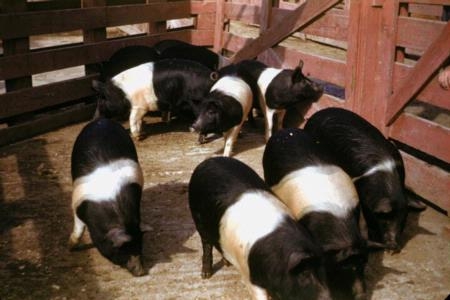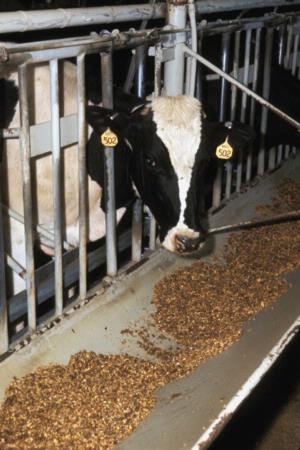Posts Tagged: air quality
Not a lot of greenhouse gas is from animal ag
There's been some confusion in recent years about the impact of animal agriculture on global warming. UC Davis Cooperative Extension air quality specialist Frank Mitloehner will share his findings on the subject this month during a free webinar on the eXtension website, according to an article in Pork magazine.
The 2006 United Nations report "Livestock's Long Shadow" said the livestock sector is responsible for 18 percent of greenhouse gas emissions, a higher share than transportation. Mitloehner said livestock's contribution is more like 3 percent, yet wide distribution of the misinformation has put Americans and others on the wrong path toward solutions.
The webinar, which will include information from Mithoehner's report "Clearing the Air: Livestock's Contribution to Climate Change," is at 11:30 a.m. Pacific Time June 11. Forum participants will have the opportunity to ask questions, post comments, upload photos and share their experiences. All the details, including links to background information and to the webinar, are in this eXtension flyer.

Black and white swine.
Valley ozone story takes off
Research by UC Davis scientists that revealed a substantial amount of San Joaquin Valley ozone is generated by animal feed is getting wide coverage in the news media. Google News reported 126 articles on the subject.
Many newspapers ran the Associated Press version of the story, written by Fresno-based Tracie Cone. She reported that the study — funded by the U.S. Department of Agriculture, California Air Resources Board and the San Joaquin Valley Air Pollution Control District — was initially intended to measure the impact of animal manure, urine and flatulence on ozone levels.
However, the researchers discovered that millions of tons of fermenting cattle feed bears greater responsibility.
Mark Grossi of the Fresno Bee noted in his story that the study was published last month in the journal Environmental Science & Technology. This week's flurry of interest was generated by an April 21 news feed from the American Chemical Society press office. ACS publishes the journal.
In his story, Grossi wrote that the cattle feed explains only half of the Valley's ozone problem. The other half, Nitrogen oxide, or NOx, comes from vehicles. San Joaquin Valley Air Pollution Control District believes NOx is more important to control, the Bee article said.Meanwhile, Capital Press reported yesterday that the U.S. Environmental Protection Agency has rescinded its long-standing exemptions for agriculture under emission-control rules.
"Air quality in the San Joaquin Valley is consistently among the worst in the nation," said Deborah Jordan, director of the Air Division for the EPA's Pacific Southwest region, in a statement. "New and modified facilities will now be subject to the most stringent requirements, which will contribute to the health of our communities."

A dairy cow eats its rations.
San Francisco meeting generates research buzz
A meeting this week of the American Chemical Society turned two interesting UC research projects into headline news.
UC Davis nutrition professor Paul Davis reported that walnuts slowed prostate tumors by 30 percent to 40 percent in mice, according to a UPI article. The dose was equivalent to 2.5 ounces for a typical man. Not only was prostate cancer growth reduced, but the mice had lower blood levels of a protein that is strongly associated with prostate cancer.Completely unrelated research presented at the meeting, also from UC Davis, questioned an often-quoted UN statistic that said animal agriculture produces 18 percent of greenhouse gas emissions, more than all transportation combined.
Air quality specialist Frank Mitloehner says the U.N. reached its conclusions for the livestock sector by adding up emissions from farm to table, including the gases produced by growing animal feed, animals' digestive emissions, and processing meat and milk into foods. However, for transportation it only considered emissions from fossil fuels burned while driving, according to a CNN story.
"This lopsided 'analysis' is a classical apples-and-oranges analogy that truly confused the issue," Mitloehner was quoted in the original UC Davis news release announcing his results.
At least one blogger wasn't fully convinced that the world can go back to eating meat guilt free. The writer of Guardian UK Environment Blog, Leo Hickman, wondered why more media outlets hadn't reported that Mitloehner receives a significant amount of research funding from the meat industry."I'm not saying that Mitloehner is a bought-off scientist in the pocket of Big Beef. . .," Hickman wrote. "My beef is that this funding information has not been deemed worthy of inclusion in the reports and blogs that have been so quick to leap on Mitloehner's findings as, in their eyes, further proof that environmentalists are just a bunch of unscientific cranks."
The American Chemical Society's national conference concludes today.

Frank Mitloehner
Summer smoke is no annomaly
As 323 active fires in California threaten more than 10,000 homes, commercial buildings and other structures, the Sacramento Bee today offered a small consolation. Even though air quality is poor and the state has already spent more than $100 million fighting blazes, the situation isn't really anything abnormal.
The Bee story, citing research by UC Berkeley environmental scientists that was led by Scott Stephens, said the amount of land burning pales compared to acreage consumed historically, before Europeans settled in California.
"The scientists estimated that an average 4.4 million acres burned annually in California before 1800, compared with an average 250,000 acres a year in the last five decades," the story says.
The smoke-filled skies are, in historical terms, unexceptional. The Berkeley researchers found that wildfires emitted on average 1.3 million tons of smoke particles a year in prehistoric California, compared with about 78,000 tons in 2006, the most recent year for which the data is available.

Wildfire was not unusual in prehistoric California.
